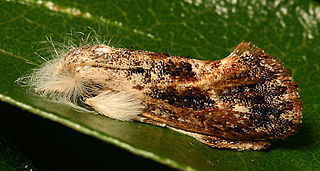Stade Barema Bocoum is a multi-use stadium in Mopti, Mali. It is currently used mostly for football matches. It serves as a home ground of Débo Mopti. It also hosted some matches for the 2002 African Cup of Nations. The stadium holds 15,000 people and was opened in 2001. It is named after foreign minister Baréma Bocoum.
Baréma Bocoum was a Malian politician and diplomat. Bocoum was the foreign minister of his country from 1961 - 1964. Stade Baréma Bocoum is named after him.Bocoum also served in the French National Assembly from 1956-1958.

Acrolophus is a genus of moths in the family Acrolophidae, with, typically, great individual variation within species in color pattern, making field identification of many individuals difficult or impossible. It was described by Felipe Poey in 1832.

Clemens' grass tubeworm moth is a moth of the family Acrolophidae. It is found in the eastern United States, from New Jersey and Ohio south to Florida and west to Illinois, Nebraska and Texas.
Acrolophus fervidus is a moth of the family Acrolophidae described by August Busck in 1912. It is found in Costa Rica, Mexico and Texas.
Acrolophus arcasalis is a moth of the family Acrolophidae. It is found in the West Indies.
Acrolophus salvini is a moth of the family Acrolophidae. It is found in Panama.
Acrolophus australis is a moth of the family Acrolophidae. It is found in the West Indies.

The Grass Tubeworm or Texas Grass Tubeworm Moth is a moth of the family Acrolophidae. It is found from Maryland to Florida and to Texas.
Acrolophus macrogaster is a moth of the family Acrolophidae. It is found in North America, including Arizona.
Walsingham's grass tubeworm moth is a moth of the family Acrolophidae. It is found in North America, including Alabama, Florida, Georgia, Illinois, Louisiana, Maryland, Mississippi, New York, Ohio, South Carolina, Tennessee, Virginia and West Virginia.
Acrolophus echinon is a moth of the family Acrolophidae. It is found in Mexico.
Acrolophus garleppi is a moth of the family Acrolophidae. It is found in Bolivia.
Acrolophus hamiferella is a moth of the family Acrolophidae. It is found in South America.
Acrolophus harparsen is a moth of the family Acrolophidae. It is found in Puerto Rico.
Acrolophus jalapae is a moth of the family Acrolophidae. It is found in South America.
Acrolophus mimasalis is a moth of the family Acrolophidae. It is found in the West Indies.
Acrolophus maculata is a moth of the family Acrolophidae. It is found in Brazil.
Acrolophus numidia is a moth of the family Acrolophidae. It is found in Mexico.
Acrolophus walsinghami is a moth of the family Acrolophidae. It is found in Puerto Rico.




